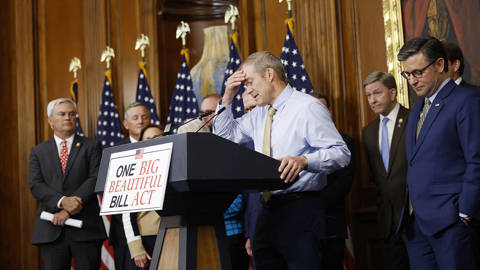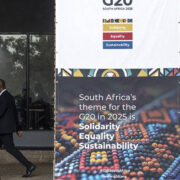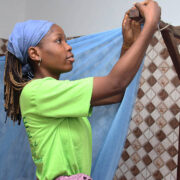
Africa’s creative industries are expanding rapidly, fueled by digital innovation and a young, growing middle class. By making strategic investments and implementing targeted reforms, African governments can harness this momentum to advance economic, social, and development goals.
WASHINGTON, DC – In February, Afrobeats singer Tems won the Grammy for Best African Music Performance. Her achievement underscores the genre’s growing popularity, exemplified by more than 15 billion streams on Spotify. It is also part of a broader cultural renaissance, as Africa’s creative industries – from music and film to fashion – rapidly expand their global reach.
- Trump’s Unworkable Trade Formula
 Johannes Eisele/AFP/Getty Images
Johannes Eisele/AFP/Getty Images - The Bonfire of the Banking Regulators?
 Bettmann/Getty Images
Bettmann/Getty Images - US Fiscal Irresponsibility Is Everyone’s Problem
 Anna Moneymaker/Getty Images
Anna Moneymaker/Getty Images
African culture’s rise to prominence could play a major role in the continent’s economic transformation, offering significant opportunities for a large and growing youth population. The creative industries are projected to account for 4% of Africa’s GDP and up to 10% of global creative exports by 2030, creating more than 20 million new jobs.
As I highlight in a new report, the growth of Africa’s creative industries is driven by two major forces: digitalization and demographic shifts. But to unlock the sector’s full economic potential, policymakers must make strategic investments and implement targeted reforms.
Digital innovation is rapidly reshaping Africa’s cultural landscape, creating new pathways to economic development. Increased access to emerging technologies is fueling the rise of digital payment platforms, while social media, streaming services, and online marketplaces are lowering entry barriers for creators and entrepreneurs. AI alone is projected to add nearly $1.5 trillion to the continent’s GDP by 2030, transforming how creative work is produced, distributed, and consumed. Between 2016 and 2022, Netflix invested $175 million in South Africa, Nigeria, and Kenya, reflecting its confidence in Africa’s creative output.
Demographic shifts are equally transformative, as the rapid expansion of Africa’s middle class and consumer base is driving demand for locally produced creative goods. By 2060, the middle class is expected to comprise more than 40% of the continent’s population. At the same time, Africa’s youth population is projected to double by 2050, making it the only region in the world with a growing working-age population. In addition to expanding Africa’s domestic markets, this demographic dividend is poised to transform the global cultural landscape, with African creators playing an increasingly influential role.
African policymakers must harness this cultural momentum to advance economic, social, and development goals. Notably, creative industries tend to employ a higher proportion of young people than other parts of the economy. With an estimated 11 million young Africans expected to enter the workforce annually through 2030, targeted investment in these industries could be a highly effective strategy for addressing the continent’s youth unemployment problem.
PS Events: London Climate Action Week 2025 
PS Events: London Climate Action Week 2025
Don’t miss our next event, taking place at London Climate Action Week. Register now and watch live on June 23 as our distinguished panelists discuss how business can fill the global climate-leadership gap.
Register Now
In sectors like fashion, around 90% of micro, small, and medium-size enterprises operate informally. Formalizing these businesses could boost productivity, broaden access to finance, and foster long-term growth. A more structured creative economy could also advance gender equality, especially in countries like Ethiopia, where women comprise roughly 85-90% of the apparel workforce.
To be sure, significant obstacles must be overcome to realize the sector’s full potential. Africa currently accounts for just 1.5% of the global creative economy and 5% of the world’s cultural and creative-industry jobs, and the sector faces persistent funding gaps, chronic underinvestment, and weak regulatory frameworks. Many African governments allocate less than 1% of their national budgets to creative industries.
Intellectual property protections remain a key vulnerability as well, with UNESCO estimating that 50-75% of African film and audiovisual revenues are lost to piracy. To tackle this challenge, governments must bolster anti-piracy laws and improve enforcement mechanisms. The African Union’s Plan of Action on Cultural and Creative Industries is a step in the right direction, but its success will depend on coordinated national implementation, the development of clear IP guidelines, and more robust institutional capacity.
Alongside IP reform, African governments should adopt business-friendly policies tailored to the unique needs of African entrepreneurs and creators. Given the high levels of informality across the sector, these frameworks must be flexible and inclusive. A prime example is Morocco’s rebate system, which attracted international productions and helped the country’s film industry achieve record profits in 2023.
Access to funding is essential. The financial measures introduced during the COVID-19 pandemic to aid the arts sector provide a useful model for how direct public investment can support creative industries. Strategic investment in digital infrastructure is also critical, especially for creative industries like fashion e-commerce.
National governments should also collaborate with regional and international funders. Encouragingly, the African Export-Import Bank announced last year that it would double its investment – to $2 billion over the next three years – in the Creative Africa Nexus initiative, which connects creative professionals and investors from across the continent.
More broadly, African governments must develop forward-looking policies that accelerate the growth of creative industries. By tapping into the talent, innovation, and entrepreneurial drive of Africa’s youth, the continent has the potential to position its creative economy as a global powerhouse, driving GDP growth, expanding cultural influence, and shaping a future defined by African-led prosperity.











Comments